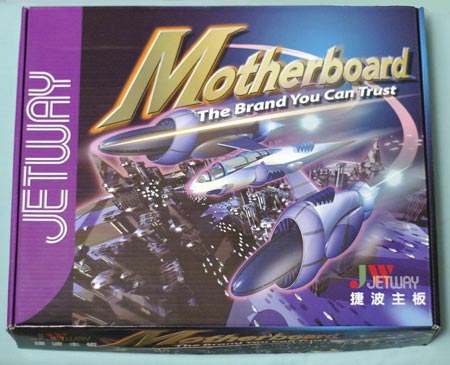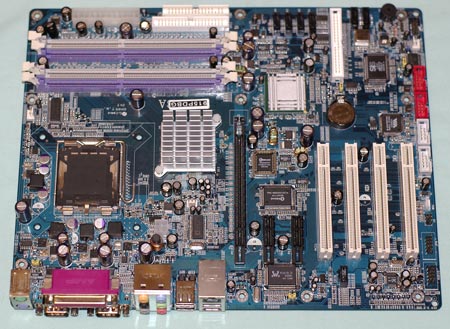915 Motherboard Roundup: Socket 775 for the Rest of Us
by Wesley Fink on December 7, 2004 12:25 AM EST- Posted in
- Motherboards
Jetway 915 PDBG: Features and Layout
| Jetway 915 PDBG Motherboard Specifications | |
| CPU Interface | Socket 775 Pentium 4 (Prescott) |
| Chipset | Intel 915P/ICH |
| BUS Speeds | 200MHz to 255MHz (in 1MHz increments) |
| DDR Speeds | Auto, 333, 400 |
| Core Voltage | 0.8375V to 1.60V in 0.0125V increments |
| DRAM Voltage | 1.80V to 2.25V in 0.05V increments |
| VDD 1.5 Voltage | 1.50V-2.0V in 0.05V increments |
| Memory Slots | Four 184-pin DDR400 Slots Dual-Channel Unbuffered Memory to 4GB |
| Expansion Slots | 1 PCIe x16 Slot 2 PCIe x1 slot 4 PCI Slots |
| Onboard SATA/RAID | 4 SATA 150 drives by ICH6 Plus 2 SATA drives by SiS180 (0, 1, 0+1) |
| Onboard IDE/RAID | One Standard ATA100/66 (2 drives) Plus 2 drives by SiS 180 (0, 1, 0+1) |
| Onboard USB 2.0/IEEE-1394 | 8 USB 2.0 ports 2 IEEE 1394 FireWire Ports by VIA VT6307S |
| Onboard LAN | Gigabit PCI Ethernet by Realtek 8100S |
| Onboard Audio | Realtek ALC880 (HD Audio) 8-Channel with SPDIF in/out |
| Tested BIOS | Award 7/07/2004 |
Jetway supplied early versions of both their 915P and 915G motherboards. The boards are the same except for the integrated Intel DX9 graphics capabilities of the G chipset. While the 915 is the "mainstream" chip in the new Socket 775 chipsets, Jetway did not short-change the features on their 915PDBG board. Included are the trademark High-Definition audio powered by the Realtek ALC880, 2 VIA Firewire ports, and Gigabit LAN running on the slower PCI bus. The Gigabit LAN would have performed better on the faster PCIe bus, but in most real applications today, you won't really notice the difference.

Jetway economized by using the ICH6 south bridge instead of the R version that supports Intel Matrix RAID. Then they added A SiS 180 controller to provide 2 needed IDE ports (total 4) to the 915 chipset and 2 more SATA ports (total 6). The added drives on the SiS 180 controller can be combined in RAID arrays if the user chooses.
The BIOS options and ranges of the Jetway 915PDGB are surprisingly complete. Memory Voltage, CPU Voltage and VDD (Chipset) voltage all have wide and useful ranges. The only BIOS adjustment that could use a boost in BIOS upgrade is the FSB adjustment, which is currently limited to a pretty low 255 setting. Jetway designed the 915P.R boards to use DDR memory to lower the cost of an upgrade to the new Socket T platform.

Jetway did a fine job in the layout of the 915PBDG. The board is a decidedly non-flashy standard green with rounded corners, but the components and connectors are in locations where they make sense. The floppy and IDE connector supported by the ICH6 are in the best location at the upper right board edge, between the memory slots and the board edge. The 24/20-pin power connector is in the same area where it belongs. While the 4-pin 12V power connector is between the CPU socket and the IO ports, it completely clears the CPU area at least, making it easier to connect and route around the CPU heatsink/fan. The 6 SATA connectors and onboard headers for features are all along board edges where they belong. It is also worth noting that the SATA connectors are the completely enclosed type, which makes the fragile SATA connector much more durable for day-in/day-out service.
We don't know if the Jetway 915PBDG will ever see the light of day in most world markets. As Anand discussed after his recent visit to Taiwan, manufacturers are extremely disappointed with the very slow sales of 915/925X boards. With supplies of 865/875 drying up, there may be a corresponding boost in 915/925X sales. If there is a boost in 915 demand, then look for the Jetway in the market. The design of the board is very good and Jetway could have a winner here with some refinement - if the market wants a 915P board.
Gigabyte 8GPNXP Duo: Overclocking and Stress Testing
Jetway 915 PDBG: Overclocking and Stress Testing










26 Comments
View All Comments
Live - Tuesday, December 7, 2004 - link
Sorry Didn't see your reply before I posted Wesley.Sure there is some value to be had but not "outstanding". I still don't agree with you but I guess my mind is made up. Intel needs to come out with something new before I go back.
As a roundup it was very good reading tough. I can't wait for the next AMD roundup to hit AnandTech.
Live - Tuesday, December 7, 2004 - link
#12"The P5GD2 is an expensive motherboard, at about $240 on the web, but you can get almost all the same features in the P5GD2 Deluxe for about $50 less."
Thats expensive to me. Compare that to the 134.99 for the 939 Gold Editors Choice winner "MSI K8N Neo2 Platinum"
But thats not the point. If the 915P was substantially cheaper then a 939 system you might call it value for money but is it not. Mind you a 939 board is generally not cheap either but at least it delivers in comparison.
The CPU used in the review that hardly beat the much cheaper 3500+ had a max overclock of 14% and I bet you would find it hard to reach that high without the CPU overheating and start throttling http://www.anandtech.com/news/shownews.aspx?i=2345...
LGA775 CPUs does not offer great overclocking headroom compared to the much cheaper earlier Intel platforms or AMD for that matter. Sure they still overclock but nothing that we haven't seen before at higher cost and temperature. Again not what I would call outstanding.
Wesley Fink - Tuesday, December 7, 2004 - link
#11 - We just ran the 3500+ benchmarks in the same configuration this morning, and we do agree that the 3500+ is a particularly good value in performance for the dollar. However, the larger picture of prices of AMD CPUs compared to Intel show the Intel processors are a good, if not outstanding, value.Our conclusion was based on Anand's value analysis in the 3.46EE/1066 launch review at http://www.anandtech.com/cpuchipsets/showdoc.aspx?... There he compared the 3800+ at over $600 to a Intel 560 3.6GHz at about $450 and found the 3800+ the winner but probably not a big enough winner to justify the price premium for the 3800+. At that time, there was no 570 (3.8GHz) and the 3.6 was the fastest Intel CPU unless you considered the $1000+ Xeon-based EE processors. Price changes continue, and with them the value relationships do change.
A quick check of prices today shows
Intel 520(2.8GHz)- $160 AMD 2800+(754) - $128
Intel 530(3.0GHz)- $180 AMD A64 3000+ - $152
Intel 540(3.2GHz)- $220 AMD A64 3200+ - $194
Intel 550(3.4GHz)- $282 AMD A64 3400+ - $269
Intel 560(3.6GHz)- $455 AMD A64 3500+ - $270
Intel 570(3.8GHz)- $795 AMD A64 3800+ - $630
AMD A64 4000+ - $716
AMD A64 FX55 - $812
With current prices we would have to agree that there is really no great value advantage to Intel any more. But there is good value in the Intel processors from 2.8GHz (520) to 3.6GHz (560). Certainly the 4000+, at $80 less than the 570 and faster performance, and the FX55 at about the same price as 570 and significantly faster in most benchmarks, are better value at the top. But we still stand by Intel being good value in the middle.
deathwalker - Tuesday, December 7, 2004 - link
"outstanding value and performance for your buying dollar" ?????????? at $240 for a Mobo?..I guess I need to retake Economics 101...Bah...Intel just continues to shot themselves in the foot. A side note not related to this review..Dell must be deep inside of Intel's pocketbook with there contiued refusal to market AMD based products.danidentity - Tuesday, December 7, 2004 - link
#11 - 915P motherboards are not expensive. They are equal or cheaper in price than socket 939 A64 motherboards.LGA775 CPUs offer great overclocking headroom if paired with the right board. Intel CPUs have traditionally have had more OCing headroom than AMD chips. That still holds true, for the most part, today. Especially when talking about the low-end chips, like the 2.8GHz.
Live - Tuesday, December 7, 2004 - link
I'm sorry but I don't see the "outstanding value and performance for your buying dollar"Expensive Motherboards and CPUs with little overclocking headroom compared to the Athlon 64 competition. How does that translate to excellent value and performance? even the much cheaper 3500 comes out on top on most benchmarks.
Sure there are niche markets where the Intel platform excels but for the big majority of us AMD is where its at right now.
I don't think this review is in sync with your conclusion so either list some valid arguments for your point (Since its not there in the benchmarks) or edit the conclusion.
danidentity - Tuesday, December 7, 2004 - link
Wesley, thanks for including tests from a more comparable AMD CPU. Listening to your readers is always appreciated.Wesley Fink - Tuesday, December 7, 2004 - link
#4,#5,#6 - The Athlon 64 results with the FX55 were included for Reference, and not direct comparison. However you do make a good point.The closest A64 we had in the lab to a 3.6GHz 560 was the 3500+ based on the 90nm process. This should provide an advantage to the Intel 560. Since there are complaints here the FX55 is too high end, these new tests tilted toward Intel should balance the playing field. The 3500+ costs about $265 and the Intel 560 (3.6GHz) is about $455, so the 560 is about 70% more expensive than the 3500+.
The added 3500+ benchmarks were also an opportunity to test with the SAME ATI X800XT PCIe we used in benchmarking the 915 boards. Enjoy!
Color codes have been updated and there are now 3500+ results on the Gigabyte nForce4 with the ATI X800XT PCIe in all benchmarks.
Original plans were to include the Intel 570 in this roundup, but much of the testing was already done when the Intel 3.8GHz CPU was launched. This Intel 3.8 is priced at around $800, which is very close to the FX55. You can see how it compares to the FX55 in performance in Anand's launch article at http://www.anandtech.com/cpuchipsets/showdoc.aspx?...
CrystalBay - Tuesday, December 7, 2004 - link
It's a pity that all these 4 dimm slot, dual channelMB's have such a rough time doing it. Imagine trying
to run 4 1GB dimms in DC, this goes for ddr1 as well 2.
Glassmaster - Tuesday, December 7, 2004 - link
Now that Northwood and 865/875 are on the way out, only a fool would buy Intel.Glassmaster.